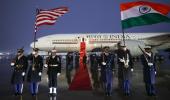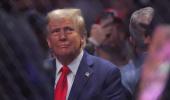The Budget has given signals that India is sensitive to US needs and willing to walk the extra mile, but if need be, we should respond in equal measure as a sovereign nation, notes Ajay Srivastava.

Customs duties are import taxes that apply to most of India's $678.2 billion imports for FY24.
The 2025 Budget introduced key changes to Customs duty across electronics, automobiles, textiles, and the healthcare sector.
While some duties were cut to boost local manufacturing and exports, others were raised to protect domestic industries.
Many changes are part of India's broader trade strategy to adapt to global shifts.
Let's look at the key Budget changes and how India prepares to stay ahead.
Average tariff levels:
India's average import tariff stands at 17 per cent, while the trade-weighted rate is lower at 12 per cent, according to the World Trade Organization's 2024 report.
The country's import duties include the Basic Customs Duty (BCD) and the Agriculture Infrastructure and Development Cess (AIDC).
In the 2025 Budget, tariffs (BCD + AIDC) were reduced on fewer than 100 products and raised on just 10 out of 12,000 tariff lines, leaving India's overall tariff structure mostly unchanged.
Tariff slabs
The government announced a simplified tariff structure, reducing the number of tariff slabs to eight.
However, this count only includes the number of BCD slabs and does not factor in the total (BCD+ AIDC) slabs, which would increase the actual number.
Even within BCD, the count excludes textiles and agricultural products, meaning the total number of slabs is still much higher than officially stated.
Duty tweaks to retain more revenue
For many products, the government maintained overall import duties at the same level but shifted part of the BCD to the AIDC.
For instance, the pre-Budget BCD on marble slabs was 40 per cent, which was split in the Budget to 20 per cent BCD and 20 per cent AIDC.
Similar changes were made for granite, candles, footwear, solar cells, luxury cars, motorcycles, bicycles, yachts, electricity meters, and electronic toy parts.
This shift allows the central government to retain more revenue, as BCD is shared with states, whereas AIDC is not.
Key tariff changes
Let us look at key product-level tariff changes in the 2025 Budget. Most changes happened in the electronics sector.
The duty on open-cell parts for LED and LCD TVs was removed to boost local display module manufacturing.
To correct an inverted duty structure, the tariff on interactive flat panel displays was raised from 10 per cent to 20 per cent.
Tariffs on smartphone components, such as PCB assembly parts, camera modules, connectors, wired headsets, and USB cables, were cut from 2.5 per cent to zero.
This may be a problem. Since components for export production are already duty-free, the government must ensure a stable five-year tariff policy to protect the fast developing local manufacturing ecosystem.
Duties are being cut on a few smartphone components in every Budget.
Duty was exempted on 63 machines used in the production of electric vehicle and mobile phone batteries.
In textiles, duties on knitted fabrics were increased, which may raise raw material costs for domestic manufacturers.
In the marine sector, the duty on frozen fish paste was cut from 30 per cent to 5 per cent, benefiting seafood processors and exporters.
The shipbuilding and shipbreaking industries received a boost through duty exemptions on inputs.
The healthcare sector benefited from duty exemptions on 36 cancer and rare disease drugs, as well as 37 essential medicines, making critical treatments more affordable.
Advantage US
The Budget also cuts tariffs on several products, which will benefit US exports to India.
Key products include Ethernet Switches (duty cuts from 20 per cent to 10 per cent), Harley-Davidson category motorcycles (from 50 per cent to 30 per cent), satellite ground installations (from 10 per cent to zero), synthetic flavouring essences (from 100 per cent to 20 per cent), and specific waste and scrap (from 5 per cent to zero).
Most US exports do not face high tariffs
While Donald Trump has highlighted an Indian tariff of 150 per cent on whiskey and 50 per cent on Harley-Davidson motorcycles, the actual tariff burden on the top 100 products, which make up three-fourths of US imports into India, is less than 5 per cent.
A few examples:
Petroleum crude, the top American export to India ($5.03 billion), is taxed at just Rs 1 per tonne.
Cut and polished diamonds ($3.09 billion) enter duty-free, as they are mostly reimports.
Coal ($4.2 billion), large aircraft ($1.94 billion), and liquefied natural gas ($1.41 billion) all face a modest 2.5 per cent tariff.
Aluminium scrap ($0.89 billion) has zero duty. The figures in the brackets are US imports from India in FY2024.
US tariffs aimed at China backfired, shifting trade instead of reducing it.
While US imports from China fell by $82 billion (2017-2023), overall imports grew by $763 billion, and China's global exports surged by $1 trillion.
While Mr Trump criticises trade partners for running surpluses with the US, he overlooks a key reason -- unlike other countries that must earn dollars to buy goods, the US can simply print them.
Next steps
As Prime Minister Narendra Modi prepares to meet President Trump, India should avoid any potential mini trade deal.
WTO rules stipulate that trade agreements with developed nations must cover substantial trade, making a limited deal legally inconsistent.
We have already signed the US-led Indo-Pacific Economic Framework Agreement, and Mr Trump shows no appetite for cutting US tariffs.
A balanced approach that considers all aspects of India-US ties is essential.
Unlike China, India gives US digital firms near-unrestricted access, generating billions in ad revenue.
Indian students contribute billions in tuition to US universities. Strategically, India remains the strongest counterbalance to China in the Indo-Pacific.
The Budget has given signals that India is sensitive to US needs and willing to walk the extra mile, but if need be, we should respond in equal measure as a sovereign nation.
Ajay Srivastava is founder, Global Trade Research Initiative.
Feature Presentation: Aslam Hunani/Rediff.com












 © 2025
© 2025